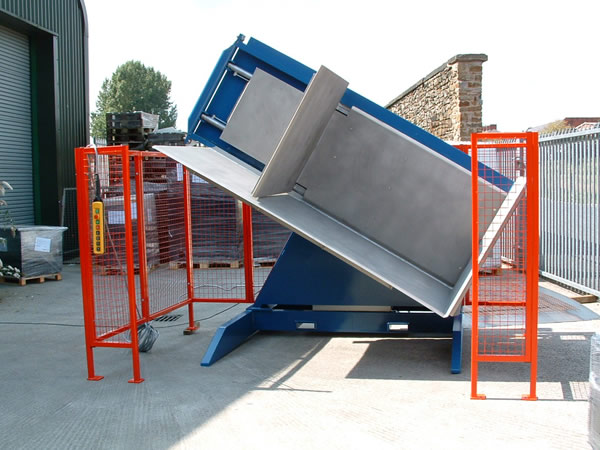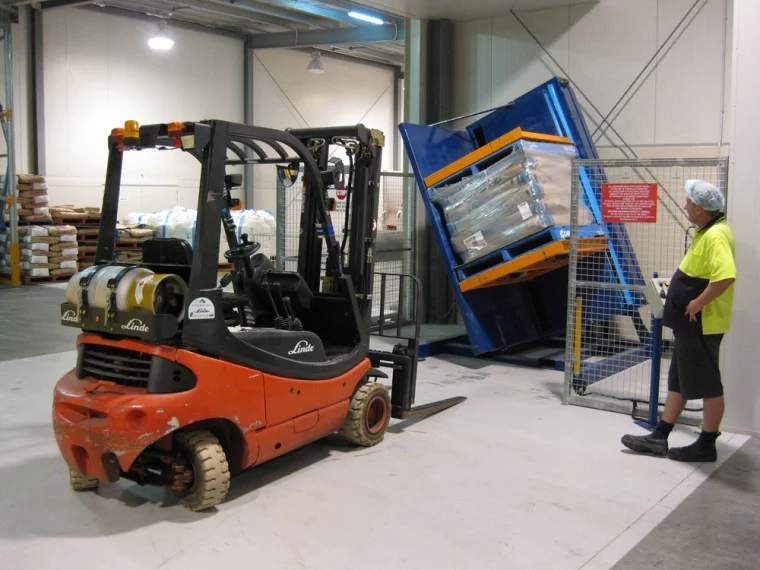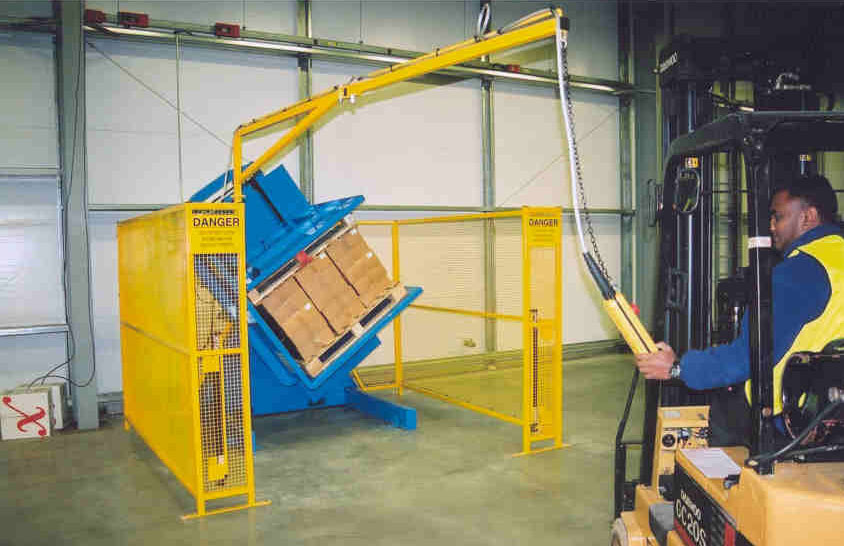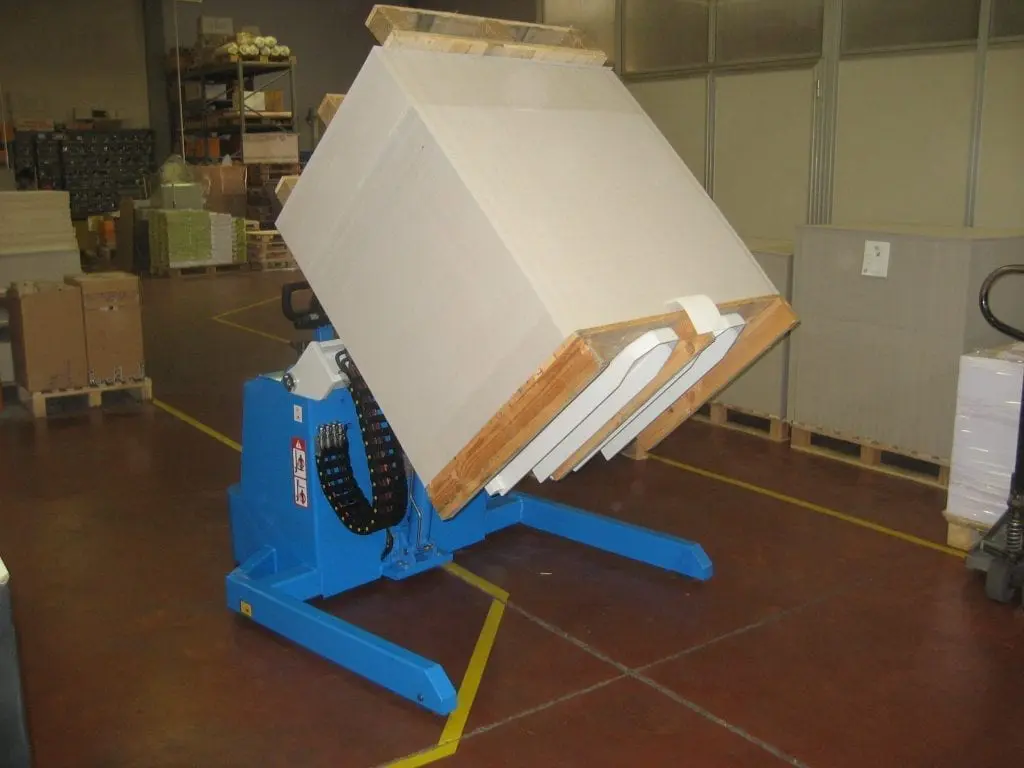Meeting Manual Handling Requirements in Thailand's Food & Pharma Industries with Automated Pallet Exchange
Are you struggling with the strict handling requirements in the food and pharmaceutical industries? Manual processes often lead to contamination risks, worker injuries, and costly inefficiencies. In a tightly regulated market like Thailand, a single mistake can damage your brand and your bottom line. I've seen many companies face this challenge, feeling trapped between rising labor costs and the fear of non-compliance. It’s a constant pressure that can slow down growth and create unnecessary stress for everyone, from the factory floor to the CEO's office.
An automated pallet exchanger is the most effective solution for meeting the demanding manual handling requirements in Thailand's food and pharma sectors. This equipment automates the transfer of goods from one pallet to another, such as from a wooden pallet to a hygienic plastic one. This process eliminates direct manual contact, drastically reduces contamination risks, prevents worker injuries, and ensures compliance with strict regulations like GMP (Good Manufacturing Practices) and HACCP.

I remember a client in Thailand who ran a successful food processing facility. He was a lot like many business owners I know—hardworking, smart, and dedicated to quality. But he was facing a big problem. His team was manually transferring heavy bags of ingredients from wooden shipping pallets to in-house plastic pallets. It was slow, physically demanding, and the risk of a torn bag or contamination was always on his mind. He knew he needed a better way. This situation reminded me of my own journey in the packing machine industry. You identify a problem, a bottleneck, and you know that the right technology is the answer. It's not just about buying a machine; it's about finding a total solution. Let’s explore how we tackled this problem and how automated pallet exchange can be that solution for you, too.
Why is manual pallet handling a major risk in food and pharma?
You might think your team is well-trained and careful, but every time a person manually handles a product or pallet, it creates an opportunity for something to go wrong. It's a risk that lurks in every corner of your facility. A moment of distraction can lead to a dropped pallet. A small oversight in hygiene can introduce contaminants. These aren't just minor issues; a single contamination event can trigger a full-scale product recall, leading to immense financial losses and, even worse, irreparable damage to your brand's reputation. Is this a risk you are willing to take day after day?
Manual pallet handling is a major risk in the food and pharma industries because it directly exposes products to potential contamination, increases the likelihood of ergonomic injuries for workers, and lacks the consistency required by strict quality standards. This manual process is a weak link that can undermine Good Manufacturing Practices (GMP) and Hazard Analysis Critical Control Point (HACCP) systems, which are fundamental for ensuring product safety and regulatory compliance.

To truly understand the danger, we need to break down the specific risks. It’s not about blaming workers; it’s about recognizing the inherent flaws in a manual system. When I started my own factory, I learned quickly that human-centric processes are prone to human error. The goal of good engineering is to design systems that make it easy for people to do the right thing and hard to do the wrong thing. In the context of pallet handling, automation isn't a luxury; it's a fundamental part of a well-engineered, safe, and efficient production line. Let's look deeper into why the "old way" of doing things is no longer good enough.
The Contamination Chain: From Floor to Product
The journey of a pallet from a delivery truck to your cleanroom is filled with contamination risks. Wooden pallets are a major problem. They are porous, can splinter, and often harbor moisture, mold, and bacteria from countless previous environments. When workers manually lift, push, and stack products from these wooden pallets onto sanitized in-house pallets, the chain of contamination begins. Dust, debris, and microbes can easily become airborne or transfer via gloves and clothing. It's a direct violation of the principles of hygienic zoning, where you must maintain a barrier between "dirty" external areas and "clean" production zones. A manual transfer process essentially breaks this barrier with every single pallet.
Ergonomic Nightmares and Worker Safety
Manual pallet handling is also an ergonomic nightmare. A standard pallet of goods can weigh over 1,000 kg. Manually unstacking and restacking these goods involves repetitive bending, lifting, and twisting—all classic causes of musculoskeletal injuries. These injuries lead to lost workdays, increased insurance premiums, and lower team morale. I've visited many factories where I've seen workers struggling with heavy loads. It is not a sustainable practice. Beyond the long-term strain, there's also the acute risk of accidents, such as dropped boxes causing foot injuries or unstable stacks toppling over. A safe workplace is an efficient workplace, and relying on manual labor for such a heavy and repetitive task is simply putting your people at unnecessary risk.
The Inefficiency of Manual Processes
From a purely business perspective, manual handling is incredibly inefficient. It's a significant bottleneck that slows down your entire internal logistics chain. The process is slow, requires multiple staff members, and its speed is inconsistent, depending heavily on the workers' stamina. This inconsistency makes it difficult to plan and schedule downstream processes accurately. You can't achieve the kind of predictable, high-throughput operation that modern manufacturing demands. This inefficiency translates directly into higher labor costs per unit and lower overall productivity.
| Metric | Manual Pallet Handling | Automated Pallet Exchange |
|---|---|---|
| Contamination Risk | High (direct contact, airborne debris) | Very Low (no-touch transfer) |
| Worker Injury Rate | High (ergonomic strain, accidents) | Negligible (process is automated) |
| Time per Pallet | 5-15 minutes (variable) | 1-2 minutes (consistent) |
| Process Consistency | Low (depends on worker) | High (machine-controlled) |
| Labor Cost per Pallet | High (2-3 workers) | Very Low (1 supervisor for multiple machines) |
How does an automated pallet exchanger solve these hygiene and safety issues?
You see the problems with manual handling and know that automation is the answer. But how exactly does a single piece of equipment, a pallet exchanger, fix all these different issues at once? It seems almost too simple. The fear is that you'll invest in a big, expensive machine only to find it doesn't solve the core problems or, worse, creates new ones. This is a valid concern, one I’ve heard from many clients who are cautious about new capital expenditures. They need assurance that the solution is not just effective but also comprehensive.
An automated pallet exchanger solves hygiene and safety issues by fundamentally re-engineering the transfer process. It securely clamps the product load, then either inverts it 180 degrees or pushes it smoothly to a new pallet. This creates a "no-touch" system that physically separates the product from manual handling and the contaminated source pallet. This automated action directly eliminates cross-contamination points and removes the dangerous ergonomic tasks for workers, tackling both hygiene and safety at their root cause.

The beauty of a pallet exchanger is in its focused design. It was engineered to do one job perfectly: transfer a load from one pallet to another without compromising the product or the people involved. It’s not a general-purpose robot; it is a specialist machine. When I was designing packaging solutions, I always followed the principle that the best solution is often the simplest one that directly addresses the main problem. The pallet exchanger is a perfect example of this. Let's dive deeper into the mechanics and design features that make it so effective.
The Mechanics of a Hygienic Transfer
There are two primary types of pallet exchangers. A pallet inverter clamps the load from the top and bottom, rotates the entire stack by 180 degrees, and allows the original pallet to be removed from the top. Then, the new, hygienic pallet is placed on top, and the load is rotated back. A pallet pusher, on the other hand, holds the load in place while pushing it horizontally from the old pallet to a new one placed alongside it. Both methods achieve the same goal: a completely hands-off transfer. The choice between them depends on the product's stability and the factory's layout. The key is that the product itself is never manually touched, and the transfer happens within a contained, controlled mechanical process.
Eliminating Cross-Contamination Between Zones
A pallet exchanger acts as a perfect gateway between different hygiene zones. Typically, it is installed in a wall opening that separates the main warehouse (the "dirty" zone) from the production or cleanroom area (the "clean" zone). A forklift on the warehouse side loads a wooden pallet into the machine. The machine performs the exchange. Then, a different forklift on the cleanroom side removes the product, now on a sanitized plastic or metal pallet. This creates an unbreakable physical barrier, preventing contaminants from wooden pallets and the warehouse environment from ever entering the clean production area. It’s a simple but incredibly powerful way to enforce hygienic zoning.
Built-in Safety Features for Operators
Modern pallet exchangers are designed with operator safety as a top priority. They come equipped with light curtains, safety fences, and pressure-sensitive mats that immediately stop the machine if a person enters the operational area. The controls are intuitive and require a two-hand operation for certain functions, ensuring the operator's hands are safely away from any moving parts. This is a stark contrast to the risks of manual handling. Instead of relying on workers to lift correctly and avoid accidents, you are implementing an engineered system with guaranteed safety protocols. This not only protects your team but also simplifies compliance with occupational health and safety regulations.
| Feature of Food/Pharma Grade Pallet Exchanger | Benefit for Your Operation |
|---|---|
| Stainless Steel Construction (304/316) | Resists corrosion from cleaning agents, easy to sterilize. |
| Wash-down Capability (IP65 rated) | Allows for high-pressure cleaning to maintain hygiene standards. |
| Smooth, Crevice-Free Surfaces | Prevents bacteria and debris from accumulating, easy to wipe down. |
| Full Safety Guarding & Light Curtains | Creates a safe zone, automatically stops machine to prevent accidents. |
| Adjustable Clamping Pressure | Securely handles various loads without crushing delicate products. |
What are the specific regulatory requirements in Thailand to consider?
So, you're convinced that automation is the way forward. But now you face another hurdle: regulations. Thailand's food and pharmaceutical sectors are governed by strict rules, and navigating them can feel like trying to read a map in the dark. You know that if you choose a machine that doesn't meet these specific standards, your investment could be worthless. Non-compliance can lead to failed audits, production halts, or even having your products blocked from the market. This is a major point of anxiety for any manufacturer operating in or exporting from Thailand.
The most important regulatory requirements in Thailand to consider for food and pharma handling equipment are those set by the Thai FDA, which are heavily based on international standards like GMP and HACCP. This means any machine, like a pallet exchanger, must be constructed from compliant materials (e.g., food-grade stainless steel), have a hygienic design that is easy to clean and inspect, and support a process that demonstrably prevents product contamination.

This is where a good equipment partner becomes more than just a supplier. They become a guide. When I work with clients, my job isn't just to sell a machine. It's to share my knowledge to ensure the solution fits perfectly within their operational and regulatory world. The regulations aren't there to make your life difficult; they are there to ensure public safety. Understanding and embracing them with the right equipment turns a potential obstacle into a mark of quality for your brand. Let's break down what you need to focus on for compliance in Thailand.
Understanding Thai FDA and GMP Guidelines
The Thai Food and Drug Administration (FDA) is the primary governing body. Their guidelines for manufacturing are closely aligned with global Good Manufacturing Practices (GMP). For equipment, this has several key implications. The machine's surface must be non-toxic, non-absorbent, and smooth. It must be resistant to corrosion from both the products it handles and the chemicals used to clean it. Essentially, the equipment itself cannot be a source of contamination. An automated pallet exchanger made from stainless steel with a hygienic design meets these core principles, making it a compliant choice right from the start.
Material and Design Specifications for Compliance
The devil is in the details. For food and pharma applications, this means specifying the right materials and design. Stainless steel grade 304 is often the standard, but for more corrosive products or aggressive cleaning protocols, grade 316 may be required. The design must avoid sharp corners, crevices, or hidden voids where bacteria could multiply. All welds should be smooth and polished. Any components that might contact the product, even indirectly, must be made from food-grade materials. When sourcing a pallet exchanger, you must demand these specifications and ensure the manufacturer can provide certification for the materials used. It's about creating a machine that is not just functional but defensible during an audit.
Documentation and Validation: Proving Your Process is Safe
Buying a compliant machine is only the first step. You also need to prove that your process is safe and repeatable. This is where documentation and validation come in. Your equipment supplier should provide comprehensive documentation, including material certificates, operational manuals, and cleaning guidelines. You will use this information to create your Standard Operating Procedures (SOPs) for the machine. For pharmaceutical applications, you may also need to conduct Installation Qualification (IQ) and Operational Qualification (OQ) tests to formally verify that the machine is installed correctly and operates according to its specifications. An automated system makes this validation much easier than a manual process, as its performance is consistent and measurable.
| Requirement Area | How a Compliant Pallet Exchanger Helps |
|---|---|
| GMP Certification | The machine's hygienic design is a key component of a GMP-compliant facility. |
| Material Traceability | The manufacturer provides certificates for stainless steel and other food-grade materials. |
| Cleaning Validation | The wash-down design and smooth surfaces make cleaning procedures effective and repeatable. |
| HACCP Plan | The exchanger serves as a Critical Control Point (CCP) to eliminate the hazard of pallet cross-contamination. |
| Process Control | Automation ensures a consistent, documented process, which is easy to validate and audit. |
What is the real ROI of an automated pallet exchanger in these industries?
Now we get to the most important question for any business owner like Javier, or like myself: What is the return on investment? A new machine is a significant capital expense. Your finance team will look at the price tag and ask tough questions. It's easy for them to see the upfront cost. It’s harder to see the hidden, ongoing costs of not automating—the slow bleed of inefficiency, the risk of a catastrophic recall, and the constant drain of high labor expenses. You know the investment makes sense, but you need to prove it with numbers.
The real ROI of an automated pallet exchanger is calculated not just from labor savings, but from a combination of factors including the elimination of product damage, prevention of costly contamination events, reduced worker compensation claims, and increased throughput. In the competitive Thai food and pharma market, most companies find that a pallet exchanger pays for itself within 18 to 36 months, after which it generates pure profit and operational stability.

When I made the leap from employee to factory owner, I learned that every dollar has to be justified. I became obsessed with ROI. An investment wasn't "good" or "bad"; it was either profitable or it wasn't. A pallet exchanger isn't just an operational improvement; it's a financial strategy. It plugs leaks in your budget that you may not even be fully aware of. Let's build a clear business case and look at how the numbers really add up.
Calculating Hard Cost Savings: Labor and Materials
This is the easiest part to calculate. First, look at labor. How many employees does it take to manually transfer a pallet? Let's say it's two people, and it takes them 10 minutes. An automated exchanger requires one supervisor (who can oversee multiple machines) and takes only 2 minutes. You can quickly calculate the direct labor savings per pallet, per day, and per year. Next, consider product damage. Manual handling leads to dropped boxes, torn bags, and crushed containers. Track this damage rate. An automated system with adjustable clamping pressure handles loads gently and securely, reducing this damage to near zero. Finally, if you are renting hygienic pallets, faster turnaround means you may need fewer of them in your fleet, reducing rental costs.
Quantifying Soft Benefits: Safety, Compliance, and Brand Reputation
This is harder to quantify but is often where the most significant value lies. How much does one worker's compensation claim for a back injury cost you in insurance premiums and lost time? A pallet exchanger nearly eliminates this risk. What is the cost of a product recall? It’s not just the lost product; it's the cost of the investigation, the damage to your brand's reputation, and the loss of customer trust. Compliance with Thai FDA and GMP standards isn't just about avoiding fines; it's a powerful marketing tool that proves your commitment to quality and safety, opening doors to more demanding and profitable customers. These "soft" benefits protect your company's long-term health and value.
A Sample ROI Calculation for a Thai Factory
Let's imagine a medium-sized food processing plant in Thailand that transfers 100 pallets per day. The numbers in a real-world scenario would look something like this. An analysis like this makes the decision clear and data-driven, which is exactly what a practical business leader needs to see. It transforms the conversation from "we can't afford this machine" to "we can't afford not to have this machine."
| Cost / Saving Category | Manual Process (Annual) | Automated Process (Annual) | Annual Savings |
|---|---|---|---|
| Labor Cost (2 workers vs 0.5) | $25,000 | $6,250 | $18,750 |
| Product Damage (1% loss rate) | $15,000 | $1,500 | $13,500 |
| Workplace Injury Costs | $5,000 (estimated avg.) | $0 | $5,000 |
| Total Annual Savings | $37,250 | ||
| Initial Investment | $60,000 (example cost) | ||
| Payback Period | ~19 Months |
Conclusion
Automating pallet exchange in Thailand's food and pharma industries is not just about compliance. It is a strategic move for efficiency, safety, and long-term profitability in a demanding market.



